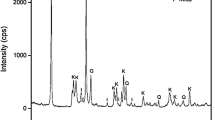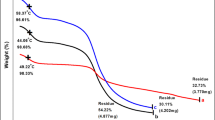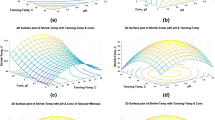Abstract
Making out animal skins or hides to leather is commonly called as tanning. This research was done for utilizing tannins of some medicinal plants and tannin induced green-synthesized silver nanoparticles along with minimal concentration of chromium to enhance the physical and mechanical properties of leather and thereby reducing the pollution caused by chromium in effluent which crucially affect the soil fertility, ground and surface water. In this study, Cassia alata, Euphorbia hirta, Thespesia populnea and Wrightia tinctoria were collected and tannins were extracted from the leaves. Tannins were utilized for production of silver nanoparticles. The extracted tannins and tannin induced silver nanoparticles were characterized, where the silver nanoparticles were found to be crystalline. Further, the tannin and tannin induced silver nanoparticles were used in leather processing either alone or in combination with chromium. The quality of tannin/silver nanoparticle treated leather was compared with chemically tanned leather for its tensile strength, tear strength, shrinking temperature, etc.











Similar content being viewed by others
References
A. S. Lawal and C. P. Odums (2015). Br. J. Appl. Sci. Technol. 5, (6), 588.
Y. Li, Z. H. Shan, S. X. Shao, and K. Q. Shi (2006). J. Soc. Leather Technol. Chem. 5, 214.
A. D. Covington Tanning Chemistry: The Science of Leather (Royal Society of Chemistry, London, 2009).
M. Doble and A. K. Kruthiventi (2007). Green Chem. Eng. 111, 245.
J. Boren and B. J. Hurd (2004). Tanning deer hides and small fur skins. New Mexico State University, Cooperative Extension Service, Las Cruces, New Mexico. Guide L-103.
D. Tegtmeyer and M. Kleban (2013). IULTCS. IUR-1, 1-10.
M. Mwinyihija, A. Meharg, J. Dawson, N. J. Strachan, and K. Killham (2006). Arch. Environ. Contam. Toxicol. 50, (3), 316.
M. Sathiyamoorthy, V. Selvi, D. Mekonnen, and S. Habtamu (2013). J. Eng. Comput. Appl. Sci. (JEC&AS) 2, (5), 17.
V. Tare, S. Gupta, and P. Bose (2003). J. Air Waste Manag. Assoc. 53, (8), 976.
S. Rajamani, R. Suthathrarajan, E. Ravindranath, A. Mulder, J. W. V. Groenestijn, and J. S. A. Langerwerf (1997). Proceedings of the 31st Leather Research Industry Get-Together; Central Leather Research Institute: Adyar, India, 57.
M. A. Jianzhong, Y. Li, B. Lu, G. Dangge, and W. Likun (2011). Accessed 24, 2.
L. Gu, M. A. Kelm, J. F. Hammerstone, Z. Zhang, G. Beecher, J. Holden, and R. L. Prior (2003). J. Mass Spectrom. 38, (12), 1272.
C. Santos-Buelga and G.Williamson, Royal Society of Chemistry (Great Britain) (2003). Methods in polyphenol analysis. Cambridge: Royal Society of Chemistry. 1–5.
A. E. Hagerman, C. T. Robbins, Y. Weerasuriya, T. C. Wilson, and C. McArthur (1992). J. Range Manag. 45, (1), 57.
C. Ogiwara, Practical Guide to Leather Processing (Tokyo Japan Ferozsons printers Ltd, Tokyo, 1980), pp. 103–123.
R. Reed (Ed.) (2016). Science for Students of Leather Technology: The Commonwealth and International Library: Technology Division a Modern Course in Leather Technology, 1.
T. C. Thorstensen Practical Leather Technology (RE Krieger Pub. Co., Florida, 1993), pp. 293–317.
F. Haojun, S. Bi, L. Shifang, and D. Zhenji (2002). China Leather. (1), 01.
Y. Lu, Y. Chen, H. Fan, B. Peng, and B. Shi (2009). International Union of Leather Technologists and Chemists Societies IULTCS XXX, in Congress. Beijing, China.
X. F. Zhang, Z. G. Liu, W. Shen, and S. Gurunathan (2016). Int. J. Mol. Sci. 17, (9), 1534.
A. V. Samrot, N. Shobana, and R. Jenna (2018). BioNanoScience 8, 632.
A. V. Samrot, P. Raji, A. J. Selvarani, and P. Nishanthini (2018). Biocatal. Agric. Biotechnol. 16, 253.
A. V. Samrot, Silky, C. V. Ignatious, P. Raji, C. SaiPriya, and J. A. Selvarani (2019). J. Pure Appl. Microbiol. https://doi.org/10.22207/jpam.13.1.
K. Renugadevi, V. Aswini, and P. Raji (2012). Asian J. Pharm. Clin. Res. 5, (4), 283.
A. J. Harborne, Phytochemical Methods a Guide to Modern Techniques of Plant Analysis (Springer, Berlin, 1998).
P. Raji, A. V. Samrot, D. B. Rohan, M. D. Kumar, R. Geetika, V. K. Sharma, and D. Keerthana (2019). Rasayan J. Chem. 12, (1), 123.
D. Dhawan and J. Gupta (2017). Int. J. Biol. Chem. 11, 17.
V. L. Singleton and J. A. Rossi (1965). American journal of Enology and Viticulture. 16, (3), 144.
S. Ahmed, M. Ahmad, B. L. Swami, and S. Ikram (2016). J. Adv. Res. 7, (1), 17.
P. Raji, A. V. Samrot, D. Keerthana, and S. Karishma (2019). J. Clust. Sci. https://doi.org/10.1007/s10876-019-01547-2.
M. Salehi, I. Kadim, O. Mahgoub, S. Negahdari, and R. E. Naeeni (2014). Anim. Prod. Sci. 54, (5), 638.
C. Y. Ishak and I. E. H. Elgailani (2016). Pak. J. Anal. Environ. Chem. 17, (1), 7.
P. Sathishkumar, J. Preethi, R. Vijayan, A. R. M. Yusoff, F. Ameen, S. Suresh, and T. Palvannan (2016). J. Photochem. Photobiol. B Biol. 163, 69.
A. T. Yusuff, A. A. Adesiyun, and T. R. Fayeye (2013). Int. J. Phytofuels Allied Sci. 2, (1), 125.
K. Lertchunhakiat, M. Keela, P. Yodmingkhwan, W. Sirirotjanaput, and A. Rungroj (2016). Agric. Agric. Sci. Procedia 11, 143.
A. Kuria, J. Ombui, A. Onyuka, A. Sasia, C. Kipyegon, P. Kaimenyi, and A. Ngugi (2016). IOSR J. Agric. Vet. Sci. (IOSRJAVS) 9, 13.
S. Sivasubramanian, B. M. Manohar, and R. Puvanakrishnan (2008). Chemosphere 70, (6), 1025.
UNIDO, Acceptable Quality Standards in the Leather and Footwear Industry (United Nations Industrial Development Organization, Vienna, 1996).
V. Suresh, M. Kanthimathi, P. Thanikaivelan, J. R. Rao, and B. U. Nair (2001). J. Clean. Prod. 9, (6), 483.
Author information
Authors and Affiliations
Corresponding author
Additional information
Publisher's Note
Springer Nature remains neutral with regard to jurisdictional claims in published maps and institutional affiliations.
Rights and permissions
About this article
Cite this article
Raji, P., Samrot, A.V., Bhavya, K.S. et al. Greener Approach for Leather Tanning Using Less Chrome with Plant Tannins and Tannins Mediated Nanoparticles. J Clust Sci 30, 1533–1543 (2019). https://doi.org/10.1007/s10876-019-01597-6
Received:
Published:
Issue Date:
DOI: https://doi.org/10.1007/s10876-019-01597-6




